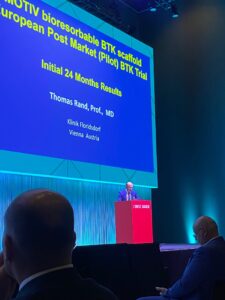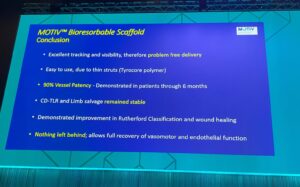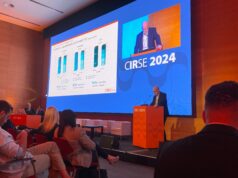
Presenting data from the MOTIV bioresorbable scaffold (Reva Medical) below-the-knee (BTK) trial during Saturday’s FIRST@CIRSE session at this year’s Cardiovascular and Interventional Radiological Society of Europe (CIRSE) 2023 annual meeting (9–13 September, Copenhagen, Denmark), Thomas Rand (Klinikum Floridsdorf, Vienna, Austria) underlined the “promising future applications” of the device for the treatment of BTK arteries in patients with rest pain or minor tissue loss due to chronic limb-threatening ischaemia (CLTI), which allowed for “full recovery of vasomotor and endothelial function” at 24-month follow-up, the investigators assert.
Theirs was a prospective, multicentre study, with a total of 58 patients, 60 study limbs and 76 Motiv scaffolds. The study involved patients with lesions in BTK arteries of a maximum of 100mm length, with Rutherford classification scores ranging from four to five. Referencing Chong and fellow presenters in this session, Rand stated that their patient demographics are “more or less the same”, consisting of “many” diabetic patients.
 Presenting their updated results, Rand conveyed their “excellent” outcomes, underlining data which show a 2% clinically-driven TLR rate and 95% limb-salvage rate among their patient cohort. Continuing, he reported “high primary patency rates”—81.7% at 24-months—and presented a 98.3% CD-TLR outcome, including a case study to visually bolster these data and display the positive healing results of an individual in their patient population.
Presenting their updated results, Rand conveyed their “excellent” outcomes, underlining data which show a 2% clinically-driven TLR rate and 95% limb-salvage rate among their patient cohort. Continuing, he reported “high primary patency rates”—81.7% at 24-months—and presented a 98.3% CD-TLR outcome, including a case study to visually bolster these data and display the positive healing results of an individual in their patient population.
“We are very optimistic for the future,” Rand told the CIRSE 2023 audience, concluding that the “excellent tracking and visibility” which has provided them “problem free delivery” and offers demonstrable “[improvements] in Rutherford classification and wound healing”. Finally, Rand made mention of a “new concept” which promotes a “leave nothing behind” best approach, which he stated the Motiv scaffold can facilitate, allowing for “full recovery of vasomotor and endothelial function”.










